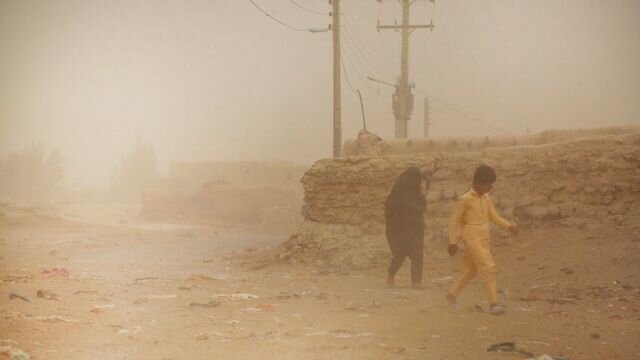SDSs, drying wetlands increasing alarmingly

TEHRAN – The occurrence of sand and dust storms (SDSs) phenomenon is increasing alarmingly across the country due to drying up wetlands, which is worrisome, head of deserts at the Forests, Rangelands, and Watershed Management Organization has stated.
The occurrence of drought and lack of water rights for wetlands are the most important causes of land degradation and desertification, which are caused by climate change and human involvement, ILNA quoted Vahid Jafarian as saying on Monday.
Emphasizing that the vegetation of floodplains plays a key role in stabilizing the soil and preventing wind erosion, Jafarian said that the occurrence of flood currents is vital for soil moisture and the regeneration and survival of plants in these areas.
More than 30 million hectares of land in the country are affected by wind erosion and about 13.9 million hectares of this area, located in cities and villages, agricultural land, and industrial towns, are causing significant damage to the infrastructure, he explained.
Wind erosion incurs an annual loss of $714 million (at the official rate of 42,000 rials). Wind erosion incurs an annual loss of 30 trillion rials (nearly $714 million at the official rate of 42,000 rials) for the country, according to the study conducted in 2019, he lamented.
The crisis is rooted in the imbalance between the amount of available water and its consumption and the lack of a comprehensive program for sustainable management of water and soil resources and the lack of approaches based on promoting resilience and adaptation to water scarcity, Jafarian stated.
“At present, the methods of rehabilitating desert areas are based on the pattern of prevention of destructive factors and the implementation of projects such as conservation and control of livestock grazing, development of compatible native species, and wastewater management.
However, the stability and durability of such measures against wind erosion depend on a series of external factors that in case of inefficiency and improper management of soil and water resources; vegetation and sensitive ecosystems in desert areas will be the first victims,” he said.
Preventing land degradation and desertification should be a priority on the agenda of national and provincial planning and sustainable land management, as well as the participation of local communities and effective cooperation of related bodies, he suggested.
SDS a major challenge to sustainable development
Dust storms are a major challenge to sustainable development, especially in arid and semi-arid regions, where more than 151 countries are directly affected, and 45 countries are classified as SDS source areas, according to UNCCD.
Dust storm belts range from the Sahara Desert and West Asia to the Great Desert of India and the deserts of central latitudes of Central Asia, China, and Mongolia. Thus, with such a wide range of cross-border effects, managing dust storms requires global and regional cooperation.
The most important factors of dust storms are land degradation, desertification, climate change, unsustainable land, and water use, strong winds, increasing drought, and its severity over time.
Natural sources of SDSs (including dried lakes and rangelands affected by vegetation depletion) account for 75 percent of the world’s dust emissions and the share of human-caused SDSs (such as land-use change, agriculture, water diversion, and deforestation) is about 25 percent.
Dust storms have both internal and external origins, but their negative consequences are very wide and include serious risks to human health up to major economic losses in the fields of transportation, agriculture, water, and air quality.
Internal SDSs hotspots
Masoud Tajrishi, deputy head of the Department of Environment (DOE) for the human environment stated in June that a total budget of €450 million has been earmarked to contain sand and dust storms (SDSs) nationwide over the past three years.
Accordingly, in 2017, a special working group called "national headquarters for SDSs control" was formed, which has been able to manage this issue to a very good extent, he further highlighted.
Tajrishi went on to state that the headquarters first identified internal and external dust hotspots, based on which it was determined that about 35 million hectares are generating dust in the country, two million hectares of which are in critical condition.
Studies have shown that 40 percent of the critical dust sources are dried wetlands. To manage this section, we are going to have a meeting with the Ministry of Energy, he added.
About 350 million hectares of surrounding countries affect Iran, which is mainly raised from Iraq, Syria, Saudi Arabia, Afghanistan, the United Arab Emirates, Oman, and Turkmenistan, he noted, adding, so that the Ministry of Foreign affairs started negotiations with the international community to tackle the problem.
During this period, about 110,000 hectares undergone seedling plantation, more than 750,000 hectares of protection, trapping and grazing operations in pastures with dust-raising potential, soil stabilization in 150,000 hectares, including mulching, construction of live and non-living windbreaks, equipping 100 stations for forecasting and warning, about 360 thousand cubic meters of dredging operations, improving routes for water to reach wetlands and about 100 kilometers of water transmission channels to humidify areas with dust potential in 27 dusty provinces were among the actions have been taken, he explained.
FB/MG
